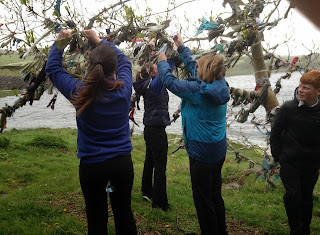 |
| Ballyshannon in the snow (Andrew Fenton) |
The Great Snow of 1947 in Ballyshannon
Anthony Begley
“Ballyshannon Genealogy and History”
On this day Pancake Tuesday 25th February 2020 remembering the Great Snow of 1947 in Ballyshannon which left the town and countryside snowbound, on the same day and date Tuesday 25th February 1947.
Snow blizzards gripping the country are
well reported in the media and local people look back to previous spells of Arctic
weather to compare how people coped with the situation in the Ballyshannon
area. Folk
memory of the big snow which fell all over Ireland in February 1947 and which
resulted in 20-30 days of snowfall between February and March are readily
recalled by those who lived through this phenomenon. The snow which fell was of
a dry powdery type and driven by an east wind it rapidly covered the landscape
and enveloped ditches and electricity poles. Farmers had the added difficulty
of foddering cattle and sheep and transport ground to a halt which resulted in
continued shortages which followed on from the World War. The cold spell continued
into March with Arctic conditions and
snowdrifts causing chaos to people’s lives. The snow was still visible on the
mountains near Ballyshannon in the month of May.
The Year of
the Big Snow in Ballyshannon 1947- A Lost Car
Local people can still recall the Big Snow of 1947
when there were immense drifts of snow obliterating pathways, roads and
significant landmarks. In Ballyshannon
heavy snow fell for 24 hours commencing on Tuesday 25th of February 1947.On
Tuesday transport was able to run during
the day but by nightfall an easterly gale piled the snow into drifts and filled
roads and lanes to hedge-top level. The
last bus from Ennniskillen to Ballyshannon was snowbound on Tuesday. The G.N.R.
train due in the town at 9 p.m. did not arrive as the line was blocked at
Irvinestown. Mr. William Carson, the station master, and his crew, brewed tea
for the 20 passengers who were bound for Kesh, Pettigo, Ballyshannon and
Bundoran. A coach was specially heated and
the passengers were made comfortable for the night. On Wednesday they
got meals in an hotel in Irvinestown and the train then ploughed its way
through the drifts reaching Ballyshannon at 7 p.m. on Wednesday. By Wednesday
the streets of Ballyshannon were deep in snow and all movement of vehicular
traffic ceased. The only bus to reach
Ballyshannon was the workers bus
fromTullaghan driven by Jack McAllister which took four hours and twenty
minutes for the short journey. All other traffic into the town from the Sligo
direction was hampered when a G.N.R. lorry got stuck in a snow drift near
Castegal Post Office. This road remained closed until Friday of that week.
Evidence of how deep the snow drifts were revealed in an incident on the Sligo
road where a motorist got stuck and went for assistance. On his return he was
unable to find the car as it was buried in a snowdrift.
Power Failure and a Novel Way to Deliver Milk
Bread vans were unable to travel but townspeople
were fortunate as The Ballyshannon Bakery supplied their needs. Rural milk
sellers braved the elements to deliver milk in the town and Mr. Ward of
Higginstown had a novel delivery method as he delivered milk with a horse-drawn
sleigh. Secondary roads were completely impassible and those who worked in the
town had to pick tracks through the
fields. Ballyshannon ground to a halt with the G.N.R. station closed and all
work on the Erne Hydro-Electric Scheme ceased. Curiously enough “The Wee Train”
as the C.D.R train was called, only lost one hour off its full schedule and was
the only lifeline with the outside world. An electrical breakdown at Shannon
blacked out the Erne and Abbey Cinema, the Convent and the Sheil Hospital. The
old Blackstone generator of the Myles Electrical Works provided the rest of the
town with electricity until the E.S.B. resumed service on Thursday. News from
the papers and letter communication were hampered by the snow drifts.
Town Shutdown
One bright spot was that schools were closed and
the young and not so young had great fun with snowball fights and sleighing on
the peaceful streets of the town. A funeral in the town on Wednesday required
six men to carry the coffin with hand slings as it was impossible for the
hearse to travel. A local turf lorry had an adventurous journey from Gweedore
on Wednesday afternoon as it set out for Ballyshannon at 3 p.m. They dug their
way through snow drifts at Doochary and Glenties and eventually made it as far
as Ballintra in the early hours of Thursday morning. They encountered their
deepest drifts there but eventually made it to Ballyshannon, sleepless,foodless
and exhausted at 11 a.m. on Thursday. Train services resumed on Thursday with
outstanding mail arriving in town but only the Belfast and Derry newspapers
arrived. No bus had arrived from Sligo by Friday. It was hoped to use an Erne
bulldozer to clear the streets and gangs of council men were employed to clear
the station and the Beleek, Bundoran and Donegal approaches into the town.
The Winter of 1947 is frequently cited as a
landmark event by those who lived through the arctic conditions and hardships
of the time.
A Local History book available in a quality limited hardback edition with dustcover as above in : A Novel Idea Bookshop Ballyshannon, Local Hands Ballyshannon and Four Master's Bookshop Donegal Town and for postal delivery contact the author anthonyrbegley@hotmail.com









